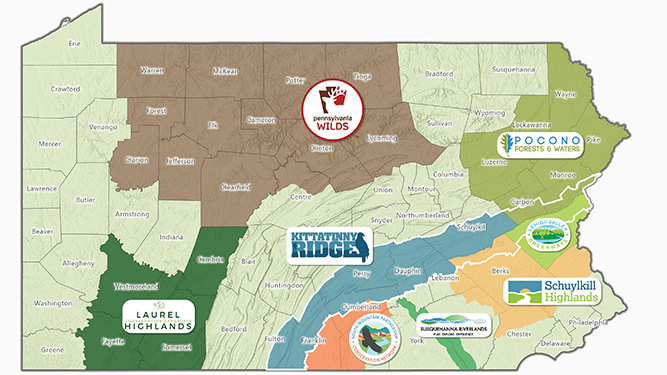Conservation Landscapes
Throughout Pennsylvania, eight large regions are working together to drive strategic investment and actions around sustainability, conservation, community revitalization, and recreational projects.
Known as conservation landscapes, these collaborations are found in regions where there are strong natural assets, local readiness and buy-in, and state-level investment and support.
Founded on the regions’ sense of place and resource values, conservation landscapes motivate citizens and elected officials to take on the challenge of effective land use planning, investment, civic engagement, and revitalization.
What Makes a Region a Conservation Landscape?
Driven by the values of conservation, sustainability, and community revitalization, conservation landscapes are built on several ingredients:
Strategic investments -- State agencies with regional and statewide partners provide high-level leadership, financial support, and technical assistance to build better communities, to conserve identified values and to invest in “sustainable” economic development
Models of Successful Collaboration
Since 2004, Pennsylvania’s Conservation Landscape Program has been using place-based partnerships to drive strategic investments and actions around sustainability, conservation, community revitalization, and recreation projects.
In 2019, DCNR had an independent evaluation of the program conducted to better understand the:
The report,
2019 Pennsylvania Conservation Landscapes -- Models for Successful Collaboration (PDF), shares the results and best practices, and makes some recommendations to strengthen the program and position it to tackle landscape-scale conservation challenges.
Conservation Landscapes in Pennsylvania

There are currently eight conservation landscape partnerships within Pennsylvania:
Kittatinny Ridge -- Conserving a critical natural asset that provides important habitat for wildlife, clean water, and extensive recreational opportunities
Laurel Highlands -- Conserving and promoting the recreational and cultural aspects of an area in southwestern Pennsylvania defined by three Allegheny Plateau ridges and portions of several watersheds
Lehigh Valley Greenways -- Using greenways and trails to connect natural and cultural resources in Lehigh and Northampton counties
Pennsylvania Wilds -- Heralding the significant outdoor experiences and rural community character found in a 12-county region in northcentral and northwestern Pennsylvania
Poconos Forests and Waters -- Focusing on land protection and history in two distinct areas in Pike, Monroe, Lackawanna, Luzerne, Wayne, and Carbon counties
Schuylkill Highlands -- Protecting trails and lands in some of the state’s most populated communities in Berks, Bucks, Chester, Lebanon, Lancaster, Lehigh, and Montgomery counties
South Mountain -- Highlighting the natural, aesthetic, historic, cultural, community, agricultural, and recreational resources in southcentral Pennsylvania
Susquehanna Riverlands -- Conserving the greenway corridor of river lands along the Susquehanna River in Lancaster and York counties